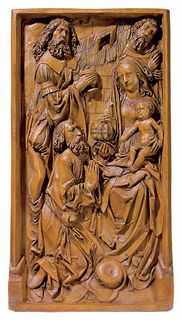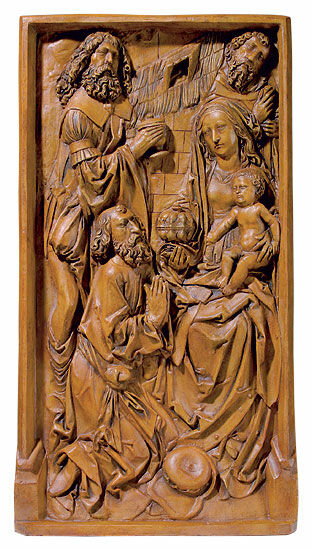Relief "Adoration of the Magi", cast
Relief "Adoration of the Magi", cast
Quick info
museum replica | cast | handmade | hand-patinated | size 105 x 57 cm | weight 28 kg
Detailed description
Relief "Adoration of the Magi", cast
With a carving depth of approx. 5 cm, this work, also known as the "London Adoration Relief", is the most beautiful surviving high relief by the master. It was probably the left-wing of the no longer existing Rothenburg Annen Altar. In 1855 the original was sold to the British Museum and is now displayed in the Victoria and Albert Museum, London. Absolutely authentic ars mundi museum replica of outstanding quality.
Polymer bound cast, hand cast and hand patinated. Size 105 x 57 cm, weight 28 kg.
About Tilman Riemenschneider
Around 1460-1531
The works of Tilman Riemenschneider represent the transition from the Middle Ages to the Renaissance like hardly any other sculptor. With his outstanding genius craftsmanship, he breathed new life into the old traditions. He was the first artist to frequently dispense with painting his works and discovered the play of light and shadow as a creative element. In this way, he created magnificent compositions full of emotional tension, in which he brought his figures to life with expressive faces, accentuated gestures and dramatic drapery.
The carver and sculptor Tilman Riemenschneider was born around 1460 in the Harz region in Germany and died in 1531 in Würzburg. Through his wanderings, he was able to visit Swabia and the Upper Rhine. He finally settled in Würzburg, where he achieved such renown that he was elected mayor.
Riemenschneider's works tie in with Swabian and Upper Rhine art in the tradition of Gerhaert van Leyden. However, the depictions also show that he must have been familiar with the prints of his contemporaries Martin Schongauer and Albrecht Dürer. Riemenschneider progressed from a two-dimensional interweaving of forms to ever greater spatiality. His multi-figure compositions became structured.
His preferred materials were lime wood and Franconian sandstone, but also marble and alabaster.
Riemenschneider became famous for his altars. His best known is the Altar of Maria in Creglingen. Riemenschneider was an innovator primarily in carved altars: he was one of the first sculptors to dispense with coloured painting. His figures differ from the contemporary late Gothic in their lyrical tenderness and inwardness.
A sculptural technique where the artwork is cut in from a stone or wooden surface and not modelled.
There are different degrees of relief depending on the degree of projection. The range includes low relief/bas-relief and high relief. The sunk relief is a common form of reliefs in Ancient Egypt, in which the depicted scenes were cut into the stone or wood surface.
Among the most famous reliefs are the works of the Florentine master Lorenzo Ghiberti. Among other artworks, he created the pair of gilded bronze doors of the Baptistery in Florence, called by Michelangelo the "Gates of Paradise".
A true-to-the-original reproduction of an artwork in the same size and with the best possible material and colour uniformity.
The mould is usually taken directly from the original so that the replication reproduces even the finest details. After casting the replication, using the most appropriate method, the surface is polished, patinated, gilded or painted according to the original.
A replication of ars mundi is a recognizable copy of the original.


